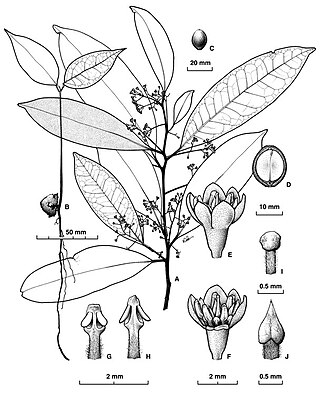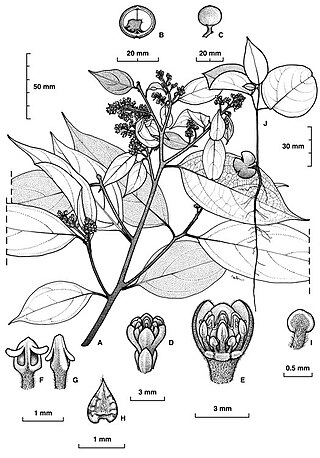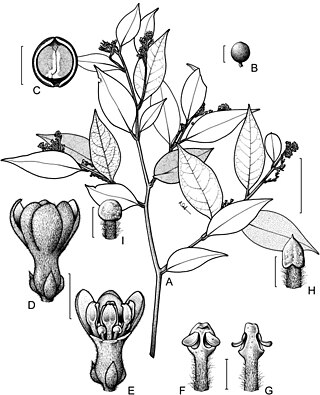
Hedycarya angustifolia, commonly known as native mulberry, Australian mulberry, or djelwuck is a species of flowering plant in the family Monimiaceae, and is endemic to eastern Australia. It is a shrub or small tree with elliptic or egg-shaped to lance-shaped leaves and male and female flowers on separate plants. Male flowers are borne in branched clusters of 5 to 16 and have 8 tepals and about 50 stamens and female flowers have about 12 tepals and 40 to 50 carpels. The fruit is a more or less spherical, tightly clustered yellow or orange drupes.

Cryptocarya bidwillii, commonly known as yellow laurel, is a species of flowering plant in the laurel family and is endemic to eastern Australia. Its leaves are lance-shaped to elliptic, the flowers creamy-white and tube-shaped, and the fruit an elliptic black drupe.

Persoonia confertiflora, commonly known as cluster-flower geebung, is a species of flowering plant in the family Proteaceae and is endemic to south-eastern Australia. It is an erect to low-lying shrub with hairy young branches, egg-shaped to narrow elliptic leaves, and hairy yellow flowers borne on leaf axils or on the ends of short branches.

Persoonia conjuncta is a species of flowering plant in the family Proteaceae and is endemic to eastern New South Wales. It is an erect shrub or small tree with narrow elliptic to lance-shaped leaves, yellow, tube-shaped flowers in groups of up to sixteen and green fruit.
Elaeocarpus miegei is a species of flowering plant in the family Elaeocarpaceae and is native to New Guinea, the Bismarck Archipelago, the Solomon Islands and the Tiwi Islands of the Northern Territory. It is a tall tree with lance-shaped to egg-shaped leaves with the narrower end towards the base, whitish to cream-coloured flowers and bright blue, elliptical fruit.

Cryptocarya corrugata, commonly known as corduroy laurel, oak walnut, acidwood or bull's breath, is a species of flowering plant in the laurel family and is endemic to north Queensland. It is a tree with egg-shaped to elliptic leaves, the flowers creamy-green, slightly perfumed and tube-shaped, and the fruit a spherical black to bluish-black drupe.

Cryptocarya cunninghamii, commonly known as Cunningham's laurel or coconut laurel, is a species of flowering plant in the laurel family and is endemic to northern Australia. It is a tree with oblong to elliptic leaves, the flowers creamy-green and tube-shaped, and the fruit a spherical black to purplish-blackdrupe.

Palmeria foremanii, commonly known as anchor vine, is a species of flowering plant in the family Monimiaceae and is endemic to an area near the New South Wales - Queensland border. It is a tall, woody climber or scrambling shrub with usually elliptic leaves, male and female flowers on separate plants with 5 tepals, male flowers with 40 to 43 stamens, female flowers with 7 to 12 carpels, and spherical, shiny black drupes.

Cryptocarya angulata, commonly known as ivory laurel, ivory walnut, bull's breath or acidwood, is a tree in the laurel family and is endemic to north Queensland, Australia. Its leaves are lance-shaped to elliptic or egg-shaped, the flowers tube-shaped and creamy-green and the fruit a bluish or black drupe.

Cryptocarya bamagana, commonly known as Bamaga walnut, is a tree in the laurel family and is endemic to Cape York Peninsula. Its leaves are lance-shaped to elliptic or egg-shaped, the flowers cream-coloured and tube-shaped, and the fruit a spherical black drupe.

Cryptocarya bellendenkerana is a tree in the laurel family and is endemic to North Queensland. Its leaves are lance-shaped to egg-shaped, the flowers creamy-green and tube-shaped, and the fruit a spherical black drupe.

Cryptocarya brassii is a species of flowering plant in the laurel family and is native to far north Queensland and Papua New Guinea. Its leaves are elliptic to oblong or lance-shaped, the flowers cream-coloured and tube-shaped, and the fruit an elliptic black to bluish-black drupe.

Cryptocarya burckiana is a tree in the laurel family and is native to Cape York Peninsula in Queensland and to Malesia. Its leaves are lance-shaped to elliptic, the flowers cream-coloured and tube-shaped, and the fruit a spherical black drupe.
Cryptocarya cercophylla is a species of flowering plant in the laurel family and is endemism to Wooroonooran National Park in north Queensland. It is a poorly-formed tree with egg-shaped to elliptic leaves, the flowers creamy-green or cream-coloured and tube-shaped, and the fruit an elliptic, red to shiny black drupe.

Cryptocarya clarksoniana, commonly known as Clarkson's laurel, is a tree in the laurel family and is endemic to north Queensland. Its leaves are lance-shaped to elliptic, the flowers creamy-green and tube-shaped, and the fruit a spherical black drupe.

Cryptocarya claudiana, commonly known as Claudie laurel, is a tree in the laurel family and is endemic to Cape York Peninsula in Queensland. Its leaves are oblong to elliptic, the flowers creamy-green, perfumed and tube-shaped, and the fruit an elliptic or spherical black drupe.

Cryptocarya cocosoides, commonly known as coconut laurel, is a tree in the laurel family and is endemic to north Queensland. Its leaves are lance-shaped to elliptic, the flowers creamy-green, perfumed and tube-shaped, and the fruit a spherical black to purple drupe.

Cryptocarya densiflora, commonly known as cinnamon laurel or white laurel, is a tree in the laurel family and is native to north Queensland and parts of Indonesia. Its leaves are lance-shaped to elliptic, the flowers yellowish-green and brown, tube-shaped but not perfumed, and the fruit is a flattened spherical, reddish maroon drupe that turns black when ripe.

Cryptocarya dorrigoensis, commonly known as Dorrigo laurel, is a species of flowering plant in the laurel family and is native to northern New South Wales. It is a tree with lance-shaped leaves, the flowers greenish-cream to creamy-yellow but not perfumed, and the fruit is a spherical to elliptic, black to bluish-black drupe.

Cryptocarya endiandrifolia, commonly known as narrow-leaved walnut, is a species of flowering plant in the family Lauraceae family and is native to Cape York Peninsula and New Guinea. Its leaves are elliptic to oblong or lance-shaped, the flowers cream-coloured or pale green and unpleasantly perfumed, and the fruit is a spherical to elliptic black drupe.



















